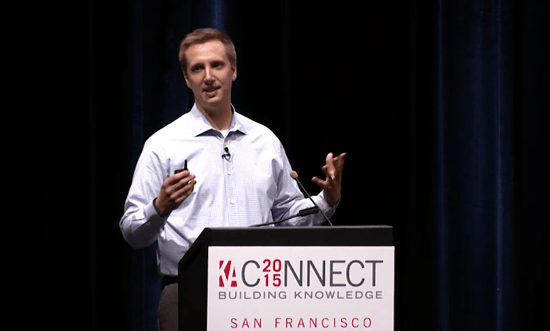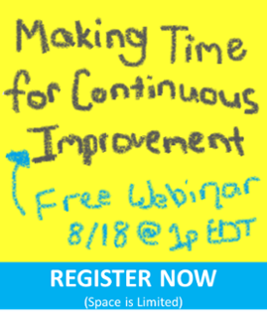Jonathan M. Bykowski, AIA, is the Principal and Practice Area Leader, Continuous Improvement for one of our customers, Array Architects. Jonathan has been deeply involved in the adoption and spread of KaiNexus as a way of supporting improvement efforts across multiple offices.
We recently found a video of Jonathan presenting at the recent KA Connect conference on knowledge management.
Watch the presentation here.
Some key points, quotes, and paraphrases, from his talk:
"We're great problem solvers, but not great problem identifiers. If we're not defining the problem the same way, we get into trouble pretty quickly."
"Lean is not just for Toyota, or hospitals, or everyone but architects. It's important to dispel any myths that Lean is just about manufacturing. It's a way to think about problems and a way to connect people and process."
We want to start rabidly questioning how we do things and why we do it, starting with why, and how we might do things differently if we want to do it better... after we decided why.
Tools aren't change. Tools are just tools. "If you can process map everything, it will be OK?" Process maps don't change things, people change things.
Don't start by copying people who you idolize. Doing daily huddles was hard because they had "clunky" daily metrics that were "forced" compared to the hospital they modeled their approach after. The daily huddles were "perfunctory at best" and didn't generate "actionable" ideas. They have changed the way they huddled, including ditching the daily metrics. Instead, they ask four key questions that are helpful.
At 6:46 into the video, Jonathan mentions their use of KaiNexus to support seven offices and "knit everybody together."
Anybody, anywhere in the firm can submit an Opportunity for Improvement from their computer or their phone. We thought OIs "would flood in fast." But "Giant OIs sank our battleship." Everybody moved to huge cultural systemic issues that they submitted as OIs, such as the hiring process. "We were not going to solve that in an afternoon."
Our goal was to get to a culture of continuous improvement. Leadership could provide support and guidance, but leadership can't generate all of the ideas or fix everything themselves.
There wasn't just a gap in leadership, but also a gap in Lean education. They have formally trained 14 staff members (about 15% of their firm) in Lean. But they "can't pull the whole organization with them." So, they decided to get everybody trained at some level of basic understanding, but not everybody needs a formal "belt" certification."
Jonathan mentions Karen Martin, one of our KaiNexus partners, and what he learned from her about focus, clarity, and discipline.
The Plan-Do-Study-Adjust (PDSA) cycle is the prime baseline tool that you use with Lean before getting into more detailed methods. "It's an elegant way to work. PDSA is infinitely scalable."
"We should be challenging and questioning what we do every day." In the PDSA model, we don't need to know the answer when we start having the discussion about the problem.
"We're most excited about the engagement. That's one of the greatest ways to retain talent at all levels of the organization, engaging them."
Thanks to Jonathan for sharing his insights and for mentioning how KaiNexus helps them spread continuous improvement.
There was also a video posted of a follow up Q&A session that immediately followed his presentation. Jonathan talks about KaiNexus supporting transparency just after 23:00 into the video.
"The danger in not communicating is far greater than accidentally sharing something that somebody shouldn't have known. So we communicate constantly."
Watch it here.
You can also read a written Q&A that we did with Jonathan here on our blog.
See how you too can make time for continuous improvement in this free webinar:





Add a Comment